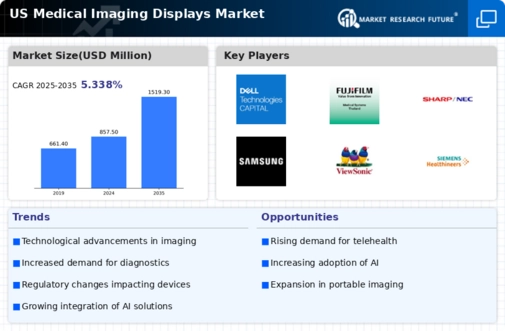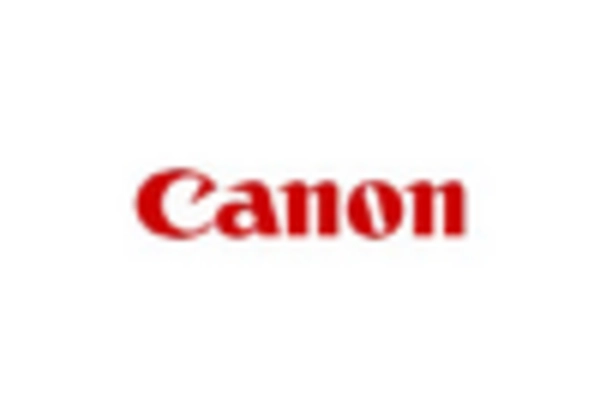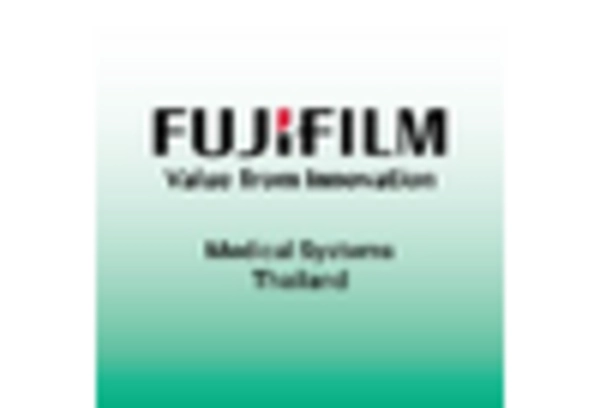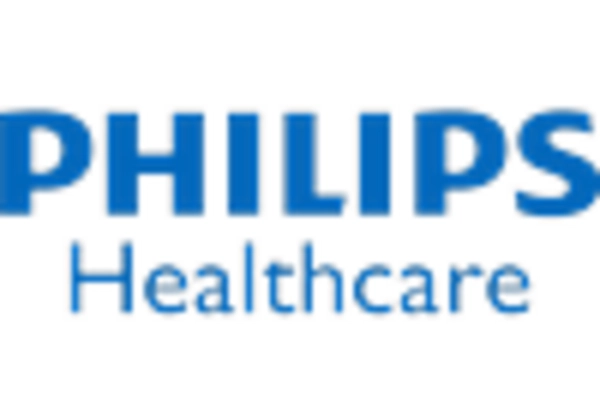Rising Healthcare Expenditure
The medical imaging-displays market is experiencing growth driven by increasing healthcare expenditure in the US. As healthcare budgets expand, hospitals and clinics are investing more in advanced imaging technologies. This trend is reflected in the projected growth of the healthcare sector, which is expected to reach approximately $4.5 trillion by 2025. Enhanced funding allows for the acquisition of high-quality imaging displays, which are essential for accurate diagnostics and treatment planning. Furthermore, the emphasis on improving patient outcomes and operational efficiency is pushing healthcare providers to upgrade their imaging systems. Consequently, this rising expenditure is likely to bolster the medical imaging-displays market, as facilities seek to enhance their diagnostic capabilities and maintain competitive advantages.
Regulatory Support and Standards
Regulatory support and the establishment of standards play a crucial role in shaping the medical imaging-displays market. The US Food and Drug Administration (FDA) has implemented guidelines that ensure the safety and efficacy of medical imaging devices. Compliance with these regulations encourages manufacturers to innovate and improve their products, fostering a competitive environment. Additionally, the introduction of standards for display quality, such as DICOM and AAPM, enhances the reliability of imaging systems. As healthcare facilities strive to meet these standards, they are likely to invest in high-quality imaging displays that comply with regulatory requirements. This regulatory framework not only promotes patient safety but also stimulates growth in the medical imaging-displays market.
Aging Population and Chronic Diseases
The shift towards an aging population in the US significantly impacts the medical imaging-displays market. As individuals age, the prevalence of chronic diseases such as cardiovascular conditions and cancer increases, necessitating advanced imaging solutions for effective diagnosis and monitoring. According to the US Census Bureau, the population aged 65 and older is projected to reach 80 million by 2040, creating a higher demand for medical imaging services. This demographic trend compels healthcare providers to invest in state-of-the-art imaging displays that can deliver precise and timely results. The growing need for regular screenings and diagnostic imaging for age-related health issues is expected to drive the medical imaging-displays market further.
Emergence of Hybrid Imaging Techniques
The emergence of hybrid imaging techniques is significantly influencing the medical imaging-displays market. Technologies such as PET/CT and SPECT/CT combine different imaging modalities to provide comprehensive diagnostic information. This integration necessitates advanced imaging displays capable of rendering complex data from multiple sources. As healthcare providers adopt these hybrid techniques to improve diagnostic accuracy and treatment planning, the demand for specialized imaging displays is expected to rise. The ability to visualize and interpret combined imaging data effectively is crucial for clinicians, thereby driving investments in high-quality displays. This trend indicates a shift towards more sophisticated imaging solutions, which is likely to propel the medical imaging-displays market in the coming years.
Increased Focus on Diagnostic Accuracy
The medical imaging-displays market is being propelled by an increased focus on diagnostic accuracy within the healthcare sector. As medical professionals strive to provide precise diagnoses, the demand for high-resolution imaging displays has surged. Enhanced display technologies, such as 4K and 8K resolutions, allow for improved visualization of intricate anatomical structures, which is vital for accurate assessments. This trend is underscored by studies indicating that diagnostic errors can lead to significant patient safety issues and increased healthcare costs. Consequently, healthcare providers are prioritizing investments in advanced imaging displays to enhance diagnostic capabilities. This heightened emphasis on accuracy is likely to drive the medical imaging-displays market as facilities seek to minimize errors and improve patient outcomes.

















Leave a Comment